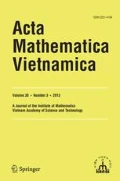Commutative algebra was born in the nineteenth century as a foundation for algebraic geometry, invariant theory, representation theory, and number theory. The classical theory was established by Dedekind, Hilbert, and Noether. Later, the rich soil of commutative algebra was cultivated by Krull, Zariski, and Nagata. In the 1950s homological algebra, developed for topology, came to commutative algebra, through the work of Auslander, Buchsbaum, Northcott, Rees and Serre, among others. In the 1960s, commutative algebra received an enormous stimulus through the work of Grothendieck and his school, and this led to intense activity in the 1970s.
Beginning in 1965, Buchberger and others developed Gröbner basis theory into a computational tool that has blossomed in computer algebra systems such as Macaulay2, CoCoA, and Singular. These tools have opened up new possibilities for experimentation and made new paradigms for studying commutative algebra and algebraic geometry possible.
In parallel to the development of computational tools, the encounter in 1975 between combinatorics and commutative algebra, led by Stanley, opened up what has turned out to be a very fertile interaction, with many applications in each direction. This area has made particularly good use of the new computational tools.
In the past quarter century, commutative algebra has experienced a striking evolution, with new and exciting connections to homological algebra, algebraic geometry, computational algebra, combinatorics, algebraic statistics and representation theory, among other areas.
This evolution was very much in evidence at the workshop “The Prospects for Commutative Algebra” that was held at Hotel Nikko Osaka, Osaka, Japan, July 10–14, 2017. The organizing committee consisted of Dale Cutkosky (University of Missouri), David Eisenbud (MSRI/University of California Berkeley), Shiro Goto (Meiji University), Jürgen Herzog (Universität Duisburg–Essen), and Takayuki Hibi (Osaka University, Chair).
The conference drew experts from around the world, and the many new results discussed, reflecting the surprising recent advances in the field, made it highly successful. There were 20 invited talks and a session of 10 contributed “Wine & Cheese Talks”. At the official banquet, Masayoshi Miyanishi, Professor Emeritus at Osaka University, presented an historical talk on “Masayoshi Nagata and Mathematics around Him in Kyoto” The talk connected the workshop with the extraordinary accomplishments of the Japanese commutative algebraists of that period.
The organizers of the conference have decided to publish a special volume dedicated to recent developments in commutative algebra and related fields. The contributors include many who have helped establish the modern trends and streams of commutative algebra. The volume addresses both researchers and graduate students studying research topics and problems in and bordering on commutative algebra: the survey articles offer an overview of the reciprocal influence between commutative algebra and some of the research fields surrounding it, while the refereed research papers highlight technical developments and suggest future directions.
We are very grateful for the generous grant from the Japan Society for the Promotion of Science Grant-in-Aid for Scientific Research entitled “The Birth of Modern Trends on Commutative Algebra and Convex Polytopes with Statistical and Computational Strategies” (JP 26220701) that provided the financial support for the conference.
Author information
Authors and Affiliations
Corresponding author
Additional information
Publisher’s Note
Springer Nature remains neutral with regard to jurisdictional claims in published maps and institutional affiliations.
Rights and permissions
About this article
Cite this article
Cutkosky, S.D., Eisenbud, D., Goto, S. et al. Preface. Acta Math Vietnam 44, 1–2 (2019). https://doi.org/10.1007/s40306-019-00328-3
Published:
Issue Date:
DOI: https://doi.org/10.1007/s40306-019-00328-3

